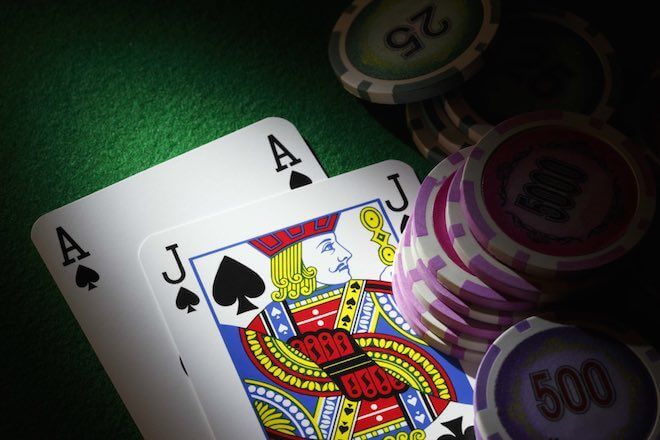You may not have ever played Black Jack before, but you sure have an idea about this casino card game. What you may not know is that it has other names such as “Twenty-one”, in English “Twenty-one”, or “Pontoon” which is the name by which it is known in the UK.
The information that you will find below will be very useful whether you plan to play in a traditional casino or if you plan to play Black Jack online or Video BlackJack on a casino website. We will explain some basic notions about the history of this casino game, its components (board or mat and cards) and how to play BlackJack (cards and counting, instructions, plays, rules , game objectives and others).
History of Black Jack
BlackJack is based on a card game that has been very popular in Spain and France since before the 17th century. The name of this game is «Twenty one» and it was mentioned for the first time in the literature in Don Quijote de la Manch a de Cervantes, in a passage in which two Spanish men cheated people from Seville by cheating them with the game of Twenty – one , where the purpose of the game was to get as close to 21 points, without going over.
This game later arrived in the United States where it did not work very well, so they added some adjustments to make it more interesting. One of them was a ten-to-one payout bonus if a player was dealt the Ace of Spades and a Black Jack . This hand was known as “blackjack” because it added up to 21 and that is why the game of “twenty-one” or “twenty-one” was renamed “BlackJack” despite the fact that the bonus was later removed by obtaining it with the dealer’s hand.
Currently , any Ace and card worth ten (regardless of the color of the card) is considered “blackjack” and usually pays 2/1, 3/2 or 6/5, depending on the payout rules of the particular casino. .
The Black Jack table
The 21 BlackJack table is very simple, since unlike roulette or Keno tables and mats, few components come into play.
Each player has a “Bet Box” to place their bets.
On the other hand, the croupier (the one who deals the cards) stands in the center of the table and deals the cards to the left.
Cards and their value
This casino card game can be played with between one and eight decks of English playing cards of 52 cards each. Each of the cards has a value:
- Aces: 1 or 11 points
- Figures (J, Q, K): 10 points
- Numbers 2 to 10 : the numerical value of the card in question
The suit (hearts, diamonds, spades and clubs) does not influence the current BlackJack game.
BlackJack Objective
The value of a blackjack hand is the sum total of the points of the cards in that hand (For example, a J and a 7 add up to 17 points). If you have read other guides or tutorials to learn how to play BlackJack, surely they have told you that the objective is to obtain a hand with a value as close to 21 as possible .
This is only half true: the ultimate goal of Black Jack is to beat the dealer (in case you are playing at an online casino such as Casino Slam ), so it doesn’t really matter that you don’t get to 21.
This is achieved by obtaining a hand higher than the dealer’s, without going over 21; which is the highest score and is obtained with an Ace and any other card with a value of 10 points (that is, a face or a 10). If you go over 21, you automatically lose .
BlackJack Procedure
1- Initial cast:
Players place their bet by placing the chips they wish to contribute in front of them. The dealer deals two cards to each player and two to himself, starting with the player to his left.
The croupier leaves his first card face down like the rest (this card is called “hole”, “hole” in Spanish) and the second card face up (in sight). If said card is an AS, the dealer will offer to make players a bet apart from the one they have already made called “Insurance” in which 2 to 1 will be paid if the dealer has BlackJack. We do not recommend that you request the Insurance ;
If, as we have said, the dealer has an AS; Before continuing with the game, he will check his “Hole” card. If this card is a 10, with which a 21 BlackJack would be added, the round ends automatically , and unless you have accepted the Insurance bet, you will lose what you had bet.
If you are playing BlackJack online, all this distribution is done automatically, while if you are playing video BlackJack, you will be able to see a real dealer from the screen of your computer or mobile device.
2. Player Action
Starting from the left, each player must choose between standing, asking, doubling, dividing or surrendering (in the next point we will see the explanation of each action in detail).
If the total value of the player’s hand exceeds 21, he loses his bet.
3. The dealer’s hand is revealed
Before claiming victory, you have to see what hand the dealer has. When all the players have taken their turn, the dealer reveals his hole card. If the value of the hand is less than 16, the dealer has to take a card from the deck again.
If with his two initial cards he adds 17 or more (called “soft 17”), the dealer stands .
4. Payment of bets
If the dealer bids, the players who haven’t bumped will still win the bet.
If the dealer does not reach 21, all players who have had a hand greater than theirs (without exceeding 21) receive payment.
In the event of a tie, bets are returned.
Player Actions (Plays)
When the player has received his two cards from the opening hand, he must choose one of these plays :
- Stand : the player keeps his cards.
- Hit – Another card is dealt to the player and added to his hand.
- Double Down : The player doubles his initial bet and receives one more card. You cannot receive any more.
- Split : if the player has a pair of 10-point cards then they can double their bet and split their cards into two separate hands. Each “hand” receives a second card. The player continues to play with two hands.
- Surrender : The player discards his hand and keeps half his original bet. This option is only available if the player has not previously requested a card and is not allowed in all casinos.
BlackJack Math Tricks and Strategies
It is not easy at all to know which of these plays is the most appropriate according to your hand. It is for this reason that there is a Basic Strategy Table that serves as a “cheat sheet” when you have doubts about whether to ask, double, divide …




